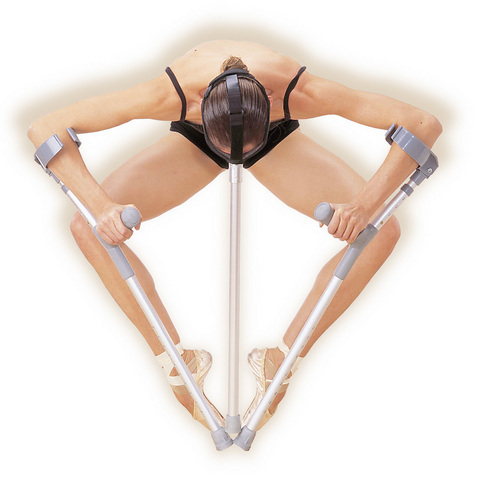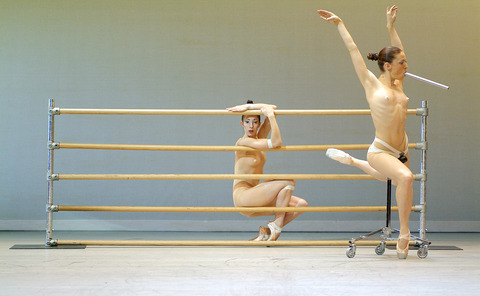Canadian dancer turned choreographer Marie Chouinard has brought her 10-person company to Taipei to show off their bodies and her latest work, bODY_rEMIX/gOLDBERGvARIATIONS at the National Theater this weekend.
Created for the Venice Biennale's International Festival of Contemporary Dance last year, Chouinard's 85-minute ballet is an exploration of the human condition and freedom -- and how limitations can often create other options, open other doors.
Freedom can also bring with it pain, just as the most beautiful examples of dancing often require pain and suffering on the part of the dancer -- as anyone who has ever seen the feet of professional ballet dancers can attest. Chouinard examines freedom and pain by taking her raw material -- the dancers' bodies -- and attaching them to a variety of props such as crutches, prostheses, harnesses and bars, not to mention skateboards and ballet point shoes worn on hands. She then explores how such devices can be a hindrance or a support or something else entirely.

A dance bar becomes the set for a duet for two male dancers, while other bars or canes become appendages, protruding from unusual places -- such as a dancer's mouth or the small of his back. The dancers remix their own bodies with the props, twisting them into new, often bizarre, forms -- turning them into some kind of mutant creatures.
Chouinard's idea was to break down dancer's patterns of movement by giving them new extensions and news ways of moving through space, whether in solos, duets or ensemble combinations, as well as different tempos and repetitions.
The canes and bars just provide concrete illustrations of the invisible lines that dancers project when they move their arms, legs or whole bodies, just as point shoes lengthen the line of the female dancer's legs. The ropes and harnesses allow Chouinard to be more of a puppet master than choreographers usually are, as her dancers walk on point through the air right into the hands of their colleagues.

PHOTOS COURTESY OF COMPAGNIE MARIE CHOUINARD
Quite aptly this ballet about variations is set to Johann Sebastian Bach's Goldberg Variations as recorded by pianist Glenn Gould, with original music by Louis Dufort. Gould's voice is also heard at times, albeit as electronically distorted as the Bach is, discussing flexible musical theory.
Not only did Chouinard choreograph the ballet, she designed the set, the lighting and the props as well.
There is some nudity, but Chouinard has stressed that she is not trying to use the nude body as a provocation or a titillation but as a manifestation of beauty and a vehicle for art.
Compagnie Marie Chouinard, now in its 16th year, is the sixth group in the seven-troupe line-up of the National Theater's Dancing into Spring festival, which began with the Neo-Classic Dance Company's Carmina Burana in early April. The festival concludes next week with the Belgian choreographer Anne Teresa De Keermaeker's troupe Rosas.
Performance Notes:
What: Compagnie Marie Chouinard
Where: National Theater, Taipei (國家戲劇院)
When: Tonight and tomorrow at 7:30pm, Sunday at 2:30pm
Tickets: NT$500, NT$700, NT$900, NT$1,200, NT$1,600, NT$2,000

May 26 to June 1 When the Qing Dynasty first took control over many parts of Taiwan in 1684, it roughly continued the Kingdom of Tungning’s administrative borders (see below), setting up one prefecture and three counties. The actual area of control covered today’s Chiayi, Tainan and Kaohsiung. The administrative center was in Taiwan Prefecture, in today’s Tainan. But as Han settlement expanded and due to rebellions and other international incidents, the administrative units became more complex. By the time Taiwan became a province of the Qing in 1887, there were three prefectures, eleven counties, three subprefectures and one directly-administered prefecture, with

Taiwan Power Co (Taipower, 台電) and the New Taipei City Government in May last year agreed to allow the activation of a spent fuel storage facility for the Jinshan Nuclear Power Plant in Shihmen District (石門). The deal ended eleven years of legal wrangling. According to the Taipower announcement, the city government engaged in repeated delays, failing to approve water and soil conservation plans. Taipower said at the time that plans for another dry storage facility for the Guosheng Nuclear Power Plant in New Taipei City’s Wanli District (萬里) remained stuck in legal limbo. Later that year an agreement was reached

What does the Taiwan People’s Party (TPP) in the Huang Kuo-chang (黃國昌) era stand for? What sets it apart from their allies, the Chinese Nationalist Party (KMT)? With some shifts in tone and emphasis, the KMT’s stances have not changed significantly since the late 2000s and the era of former president Ma Ying-jeou (馬英九). The Democratic Progressive Party’s (DPP) current platform formed in the mid-2010s under the guidance of Tsai Ing-wen (蔡英文), and current President William Lai (賴清德) campaigned on continuity. Though their ideological stances may be a bit stale, they have the advantage of being broadly understood by the voters.

In a high-rise office building in Taipei’s government district, the primary agency for maintaining links to Thailand’s 108 Yunnan villages — which are home to a population of around 200,000 descendants of the Chinese Nationalist Party (KMT) armies stranded in Thailand following the Chinese Civil War — is the Overseas Community Affairs Council (OCAC). Established in China in 1926, the OCAC was born of a mandate to support Chinese education, culture and economic development in far flung Chinese diaspora communities, which, especially in southeast Asia, had underwritten the military insurgencies against the Qing Dynasty that led to the founding of